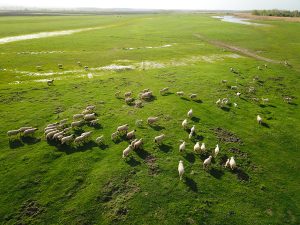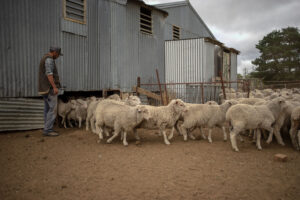New Zealand is the big broad crossbred wool producer and exporter, as well as having a good quality merino clip which is similar in size to the New England regional clip. So it is valuable to know what is going on in terms of production and price across the Tasman Sea. Detailed information (supply and price) about the Kiwi wool clip is not as readily available as our own. With this in mind, this article investigates the micron makeup of the New Zealand wool clip.
What information is available about the New Zealand wool
clip can be obtained from Beef + Lamb New Zealand (read more here), where information on
livestock production is also provided.
The New Zealand Wool Testing Authority also provides some data on wool
test volumes with graphic reports (available here).
The micron profiles provided by NZWTA have been combined between merino and
crossbred and then with the export data from Beef + Lamb New Zealand for this
article, keeping in mind the caution NZWTA makes about their micron profiles
being drawn from an incomplete record of the New Zealand clip and being based
on greasy volumes rather than clean. In essence, these micron profiles are a
guide to, not a record of the New Zealand clip.
Figure 1 shows the estimated micron profile of the New
Zealand wool clip for the 2022-23 season, ranging from 14 to over 40 microns.
The New Zealand Merino clip is the small bump ranging from 21 micron and finer
in the schematic, averaging around 17.3 micron which is close to 1.3 microns
finer than the Australian Merino average fibre diameter. Coarse crossbred wool
is the dominant type of wool produced in New Zealand with the big micron
categories being 36 to 38 micron. The Australian micron profile (drawn from
auction data which accounts for about 85% of the clip) is overlaid on Figure 1.
It shows the dominance of Merino wool production locally with the micron
profiles of the two countries nearly being mirror images.
In Figure 2 the micron profiles of the Australian (line) and
New Zealand (bars) wool clips are shown in clean metric tonnes. The Australian
clip is larger so the right-hand axis is three times that of the left-hand axis
which refers to the New Zealand volumes.
As the New Zealand merino clip is markedly finer than the
Australian merino clip, it is a significant producer at the finer edge of the
micron distribution. Figure 3 expresses the estimated New Zealand merino micron
profile as a percentage by micron category. This is imperfect as nearly all 12-micron
wool in Australia and around half of 13-micron wool is sold outside of the
auction system (read
more here), and the New Zealand volumes are estimates only. Given the
quality of the New Zealand merino clip is akin to our better tablelands clips,
the relative proportions when adjusted for quality will be even greater than
shown in Figure 3.
What does it mean?
While for the bulk of the New Zealand crossbred clip, Australian production is insignificant, there is a point of crossover for 30 micron and finer, where supply from both countries is of interest. For merino production, New Zealand production is of interest for the 17-micron and finer, as it is the equivalent of a large region of good quality production such as New England in NSW (plus Traprock for the Queenslanders). Supply is an important driver of relative prices (premiums and discounts) in the greasy wool market, so the New Zealand supply is important for these categories.
Have any questions or comments?
Key Points
- 36 to 38 micron remain the big New Zealand micron production categories.
- New Zealand has substantial 28-34 micron production, with some 5% of their crossbred clip under 25 micron.
- Below 29 micron Australian crossbred production is higher and above 29 micron Australian production is insignificant.
Click on figure to expand
Click on figure to expand
Click on figure to expand
Data sources: AWEX, NZWTA, Beef+Lamb NZ, ICS, Mecardo















